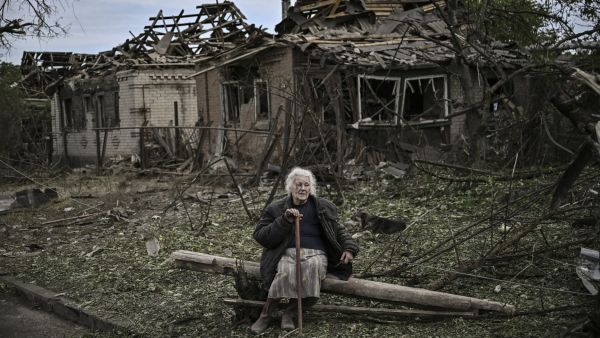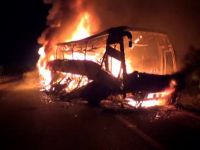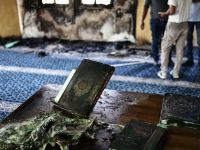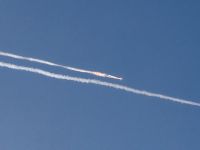ALBAWABA - On a bleak day in February, Russia sent its troops and tanks into Ukraine on grounds that the Kremlin was concerned over NATO’s eastward expansion to Ukraine towards Russian territory.
Other dubious allegations included false accusations by Russian President Vladimir Putin that Ukraine was committing genocide against ethnic Russians, calling its government a “Nazi regime.”
He also claimed that Ukraine was not a real country. “Ukraine has never had its own authentic statehood,” Putin said.
For the West, the war signaled Moscow’s quest to restore its standing as a world power, reviving the glory it enjoyed before the Republics of the Soviet Union collapsed in 1991.
Nevertheless, the invasion of Ukraine complicated the scene on the international stage and heightened fears of a looming World War III.
Ukraine is the Economist’s country of the year pic.twitter.com/4LR7O6H6y2
— KyivPost (@KyivPost) December 20, 2022
The concern was justified, considering the explicit Russian threat of using its nuclear weapons, and the earlier Western escalation, which included slapping sanctions on Moscow, ultimately halting the country’s crucial energy supply to Europe.
Subsequently, supply chains were disrupted, causing prices of oil, metals, fertilizers and foodstuffs to spike, or become scarce.
While Ukraine is considered Europe’s breadbasket, Russia is also the world’s top wheat exporter. Together with Ukraine, both account for roughly 29 percent of the global wheat export market.
China is also a big recipient of Ukrainian corn, which replaced that coming from the U.S. in 2021.
Russia and Ukraine are also big suppliers of metals and other commodities.
The following list highlights some significant developments in Russia's war on Ukraine.
Russia’s militarily intervenes in Ukraine
On Feb. 24, Russia launched its fateful war in Ukraine with thousands of its soldiers who had been massing on the Belarus-Ukraine border invading the country. President Putin then termed the invasion a "special military operation," giving the impression that it had specific objectives. But the war dragged on for 10 months and is expected to continue through the dawning of 2023. Before the outbreak of the war, French president Emmanuel Macron visited Moscow to persuade Putin not to invade Ukraine, but to no avail. He then predicted that the war that ensued would be a long conflict.
Poverty and displacement
As of December 2022, the war has swelled the poverty pockets in Ukraine, where 17.6 million people are in need of urgent assistance and protection, according to humanitarian organizations, including the United Nations. The war has internally displaced 6.3 million people. In total, however, Russia's invasion has driven 14 million Ukrainians from their homes, according to the head of the U.N. Commission for Refugees, Filippo Grandi.
The Ukraine war has pushed global displacement to a record high, resulting in the largest human displacement crisis recorded in the world today.
— Mental Health Europe (@MHESME) December 20, 2022
MHE explored the consequences of this geopolitical crisis on #MentalHealth➡️ https://t.co/yeBRzqYLrw#InternationalMigrantsDay
Soldiers killed in the Russia-Ukraine war
The figures of soldiers killed on both sides of the war, both Russian and Ukrainian, vary. Both sides have been reticent on numbers. The latest figures by the Russian Defense Minister Sergei Shoigu released in September revealed that 5,937 soldiers were killed. On the Ukrainian side, the figures swell to between 10,000-13,000 as of November, according to Mykhailo Podolyak, presidential advisor to President Volodymyr Zelensky. But the figures dramatically bounced to 100,000 for each side, according to Mark Milley, chairman of the U.S. Joint Chiefs of Staff, adding that the figures include the dead and injured.
Ukraine bans Russian books, music
On June 19, Ukraine’s parliament adopted a law that banned Russian books and music in the country. In the case of Russian books and other printed materials, the legislation made it illegal for the distribution and selling of any printed Russian material to the public. In the case of music, the law banned the broadcast, whether on TV, radio or in public places. But it noted that some Russian music could be played, provided that its composers and singers do not support the Russian military intervention. The legislation stipulated that the ban will be lifted once Russian troops withdraw from the country. Kenneth Roth of Human Rights Watch rebuked the legislation, arguing that the Kremlin and the Russian military, not the people, are waging the war.
Ukraine won't be able to join NATO for 30 years
One of the main justifications Russia used for waging its war was that Kyiv was allegedly considering joining the North Atlantic Military Organization (NATO), which would bring the pro-Western group to Russia’s doorsteps. But the Ukrainian president was in for a shock. It turned out his country couldn't join NATO for the next 30 years. This revelation was made in early August 2022 by the German chancellor Olaf Schulz, who repeated that Ukraine couldn't join NATO for 30 years. What is more surprising is that he made the revelation to Putin when he met him in Moscow in mid-February in an effort to persuade Russia against invading Ukraine. Why this point wasn't made public at the time remains a mystery. Zelensky has also reportedly long sought to join the European Union, but E.U. officials snubbed him, telling him politely there was a long waiting list.
Pope Francis and Ukraine
Pope Francis spoke bluntly on his visit to Kazakhstan on Sept. 14, saying it was a mistake to speak of a Russian-Ukraine war because in reality it’s a "world war" and should be termed as such, considering its global nature and dimension. "There is a war going on. I think it is a mistake to think of it as a cowboy movie, where there are good guys and bad guys. It is also a mistake to think that this is a war between Russia and Ukraine. No: It's a world war,” the Pontiff added. But many feel this is a "global war" the most deadly that Europe experienced since World War II of 1939-1945.
Pope Francis suggested that people celebrate “a more humble Christmas” this year by spending less on gifts and celebrations and sending the difference to Ukrainians in need.https://t.co/xk18IshL7p
— The New York Times (@nytimes) December 14, 2022
Playing with nuclear fire
The issue of a nuclear disaster has always been in the cards in the Russia-Ukraine war, but not as much as in recent weeks, when the Russian leader made implicit threats that he may use them. By Nov. 20, the International Atomic Energy Agency appealed again to the Russian and Ukrainian sides not to go near the Zaporizhzhia nuclear plant for fear of risking a conflagration and an all-out nuclear war. The problem lies in the fact that Zaporizhzhya, the largest nuclear compound in Europe with six reactors, is situated in the southeastern part of the country, near the Donetsk and Luhansk regions, the breakaway republics from Ukraine, which Russia fully supports with the rest of the area serving as a hot-bed of war. Last March Russian forces captured the Zaporizhzhia nuclear facility and it has been in their hands ever since, while the staff operating the six nuclear reactors continued to be Ukrainian. Although the reactors have been turned off, fears persist that there could still be impending disasters because of the skirmishes surrounding them and the occasional missile landing in the compound. The reactors as well need to be cooled off, and hence electricity has to continue to feed them. One of the great concerns of the IAEA is the issue of safety.
Blackouts and power cuts
On Dec. 16, Russian planes and missiles began attacking Ukrainian power lines and electricity grids with 76 missiles in a single day and incessant attacks on the country's energy infrastructure. Reports highlight that virtually every single province in the country, including the capital Kyiv experienced extended blackouts, power-cuts with no heating and cuts in the water supply systems with as many as nine power facilities being hit by cruise missiles. It is civilians who are bearing the brunt of the cold winter months with reports of some dying, while others having to live in the dark. Zelensky, the Ukrainian president, said the latest bout of attacks meant that 12 million Ukrainians are without electricity. He also appealed to the Europeans to send the country 50 million LED light bulbs to cope with the energy crisis.
Ukraine has been getting $3bn-3.5bn a month from its Western allies since the start of the war https://t.co/gOCuoovkeh
— The Economist (@TheEconomist) December 18, 2022
Kyiv under attack by Iran-made drones
The capital city of Ukraine has been under attack since the war started on 24 February. Then the Russian military believed that the capital of nearly 3 million people should be taken first, as foot soldiers escorted by tanks and armors moved downwards from Belarus in the northwest. However, this was not to be the case and the Russians continued to fight on the periphery in the eastern part of the country and to the south. Today, and as 2023 approaches, Russian firepower is not abating and is likely to continue to hit hard. On Dec. 19 for instance, Moscow hit Kyiv with 35 drones in a single day. Reports suggested the Russians were targeting critical infrastructure and that the strikes continued for days. Also, the point is being made that the drones are Iranian-made, and are being supplied by the government in Tehran, an ardent supporter of Putin. In early November, Iranian Foreign Minister Hossein Amir-Abdollahian admitted that his country provided Russia with unmanned aerial vehicles (UAVs), but noted that was months before the war began.
Cost of war for Russia and Ukraine
As the year ends, the cost of the 10-month war for Russia and Ukraine has been exorbitant. According to Forbes magazine, Russia has spent $82 billion on the military conflict. It pointed out that Russia spent $29 million on bolstering its army, $16 billion in salaries to soldiers, $9 billion to families of the servicemen killed in action, and $7.7 billion to the wounded. Additionally, Russia incurred other losses, such as military equipment, weapons and armor that have already cost it $21 billion. The war also took its toll on Ukraine, which incurred a cost of $100 billion as of August, according to calculations by the World Bank, the Ukrainian government and the European Commission. The figures showed that damage to housing was estimated at $39 billion, transport $30 billion, commerce and industry $10, and energy at $3 billion. The figures are set to increase as the war continues.
Material was compiled by Marwan Asmar and edited by Jamal Halabi.







